Robik Shrestha
Improving Multimodal Large Language Models Using Continual Learning
Oct 25, 2024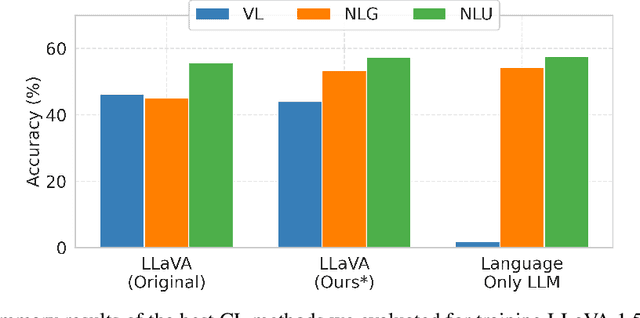

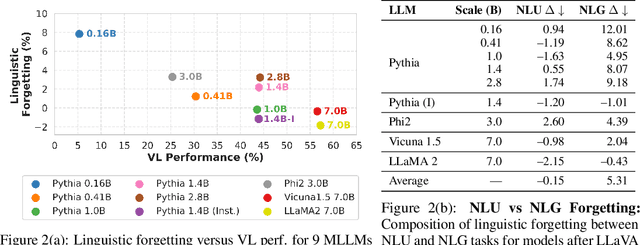

Abstract:Generative large language models (LLMs) exhibit impressive capabilities, which can be further augmented by integrating a pre-trained vision model into the original LLM to create a multimodal LLM (MLLM). However, this integration often significantly decreases performance on natural language understanding and generation tasks, compared to the original LLM. This study investigates this issue using the LLaVA MLLM, treating the integration as a continual learning problem. We evaluate five continual learning methods to mitigate forgetting and identify a technique that enhances visual understanding while minimizing linguistic performance loss. Our approach reduces linguistic performance degradation by up to 15\% over the LLaVA recipe, while maintaining high multimodal accuracy. We also demonstrate the robustness of our method through continual learning on a sequence of vision-language tasks, effectively preserving linguistic skills while acquiring new multimodal capabilities.
Revisiting Multi-Modal LLM Evaluation
Aug 09, 2024
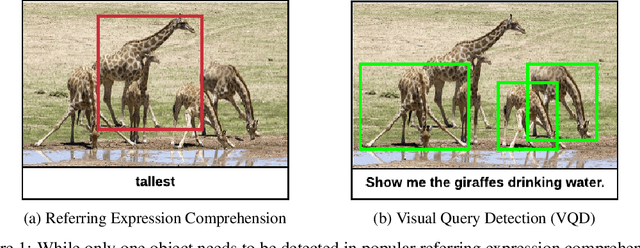

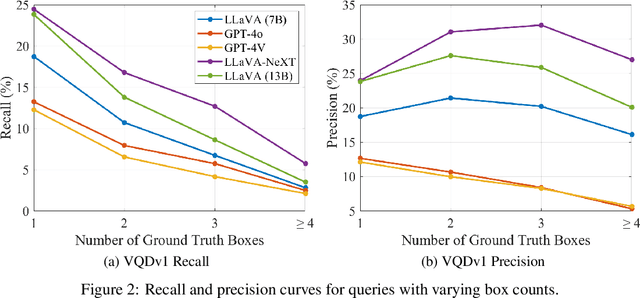
Abstract:With the advent of multi-modal large language models (MLLMs), datasets used for visual question answering (VQA) and referring expression comprehension have seen a resurgence. However, the most popular datasets used to evaluate MLLMs are some of the earliest ones created, and they have many known problems, including extreme bias, spurious correlations, and an inability to permit fine-grained analysis. In this paper, we pioneer evaluating recent MLLMs (LLaVA 1.5, LLaVA-NeXT, BLIP2, InstructBLIP, GPT-4V, and GPT-4o) on datasets designed to address weaknesses in earlier ones. We assess three VQA datasets: 1) TDIUC, which permits fine-grained analysis on 12 question types; 2) TallyQA, which has simple and complex counting questions; and 3) DVQA, which requires optical character recognition for chart understanding. We also study VQDv1, a dataset that requires identifying all image regions that satisfy a given query. Our experiments reveal the weaknesses of many MLLMs that have not previously been reported. Our code is integrated into the widely used LAVIS framework for MLLM evaluation, enabling the rapid assessment of future MLLMs. Project webpage: https://kevinlujian.github.io/MLLM_Evaluations/
FairRAG: Fair Human Generation via Fair Retrieval Augmentation
Apr 05, 2024



Abstract:Existing text-to-image generative models reflect or even amplify societal biases ingrained in their training data. This is especially concerning for human image generation where models are biased against certain demographic groups. Existing attempts to rectify this issue are hindered by the inherent limitations of the pre-trained models and fail to substantially improve demographic diversity. In this work, we introduce Fair Retrieval Augmented Generation (FairRAG), a novel framework that conditions pre-trained generative models on reference images retrieved from an external image database to improve fairness in human generation. FairRAG enables conditioning through a lightweight linear module that projects reference images into the textual space. To enhance fairness, FairRAG applies simple-yet-effective debiasing strategies, providing images from diverse demographic groups during the generative process. Extensive experiments demonstrate that FairRAG outperforms existing methods in terms of demographic diversity, image-text alignment, and image fidelity while incurring minimal computational overhead during inference.
BloomVQA: Assessing Hierarchical Multi-modal Comprehension
Dec 20, 2023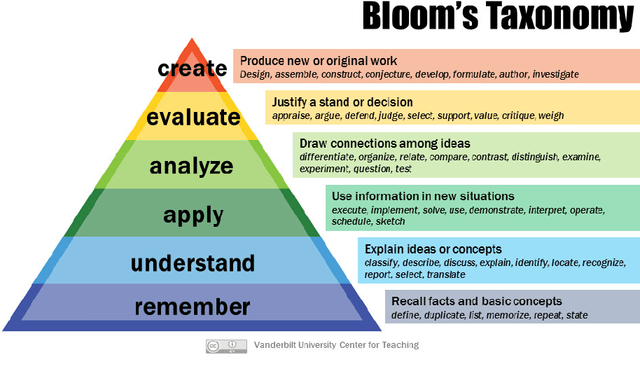
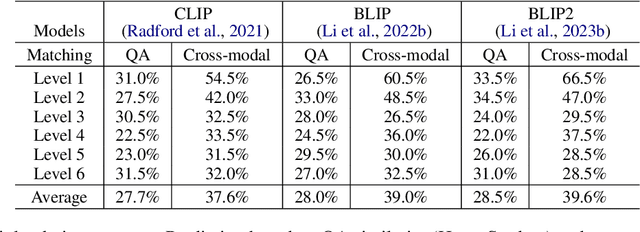
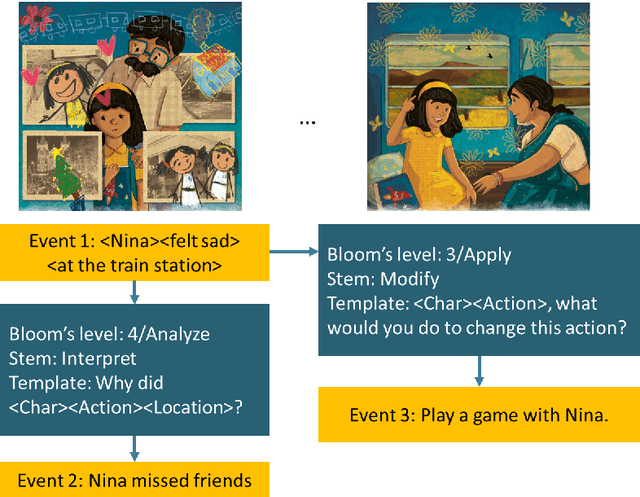

Abstract:We propose a novel VQA dataset, based on picture stories designed for educating young children, that aims to facilitate comprehensive evaluation and characterization of vision-language models on comprehension tasks. Unlike current VQA datasets that often focus on fact-based memorization and simple reasoning tasks without principled scientific grounding, we collect data containing tasks reflecting different levels of comprehension and underlying cognitive processes, as laid out in Bloom's Taxonomy, a classic framework widely adopted in education research. The proposed BloomVQA dataset can be mapped to a hierarchical graph-based representation of visual stories, enabling automatic data augmentation and novel measures characterizing model consistency across the underlying taxonomy. We demonstrate graded evaluation and reliability analysis based on our proposed consistency metrics on state-of-the-art vision-language models. Our results suggest that, while current models achieve the most gain on low-level comprehension tasks, they generally fall short on high-level tasks requiring more advanced comprehension and cognitive skills, as 38.0% drop in VQA accuracy is observed comparing lowest and highest level tasks. Furthermore, current models show consistency patterns misaligned with human comprehension in various scenarios, suggesting emergent structures of model behaviors.
OccamNets: Mitigating Dataset Bias by Favoring Simpler Hypotheses
Apr 11, 2022
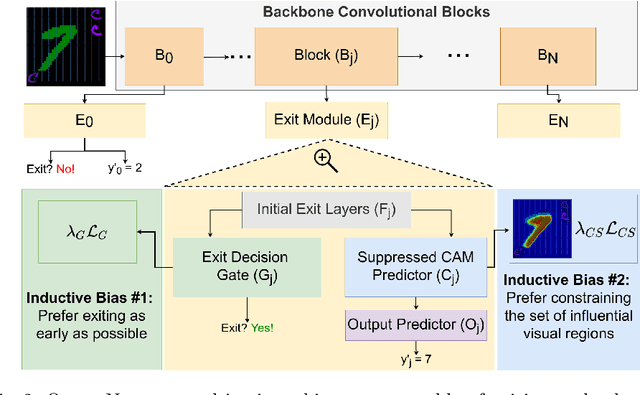


Abstract:Dataset bias and spurious correlations can significantly impair generalization in deep neural networks. Many prior efforts have addressed this problem using either alternative loss functions or sampling strategies that focus on rare patterns. We propose a new direction: modifying the network architecture to impose inductive biases that make the network robust to dataset bias. Specifically, we propose OccamNets, which are biased to favor simpler solutions by design. OccamNets have two inductive biases. First, they are biased to use as little network depth as needed for an individual example. Second, they are biased toward using fewer image locations for prediction. While OccamNets are biased toward simpler hypotheses, they can learn more complex hypotheses if necessary. In experiments, OccamNets outperform or rival state-of-the-art methods run on architectures that do not incorporate these inductive biases. Furthermore, we demonstrate that when the state-of-the-art debiasing methods are combined with OccamNets results further improve.
An Investigation of Critical Issues in Bias Mitigation Techniques
Apr 01, 2021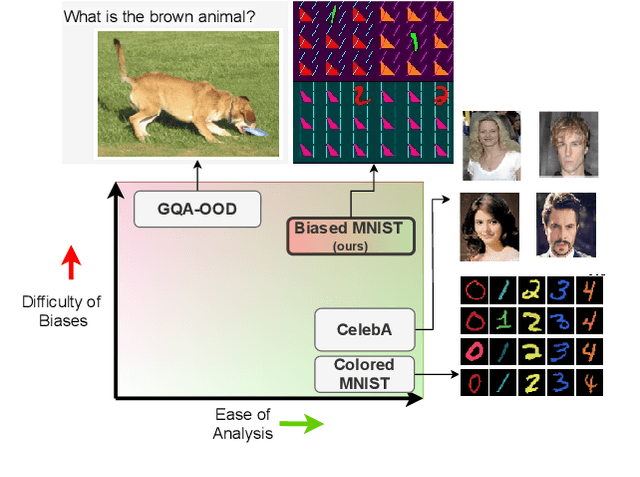
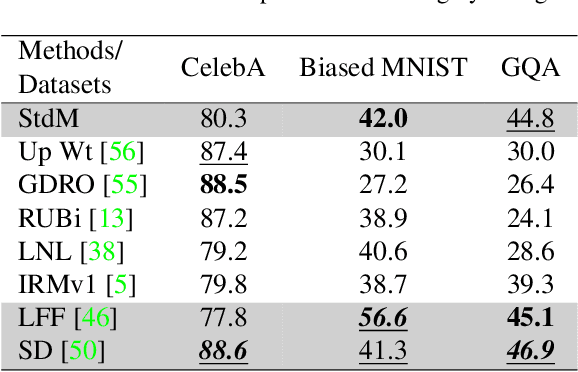
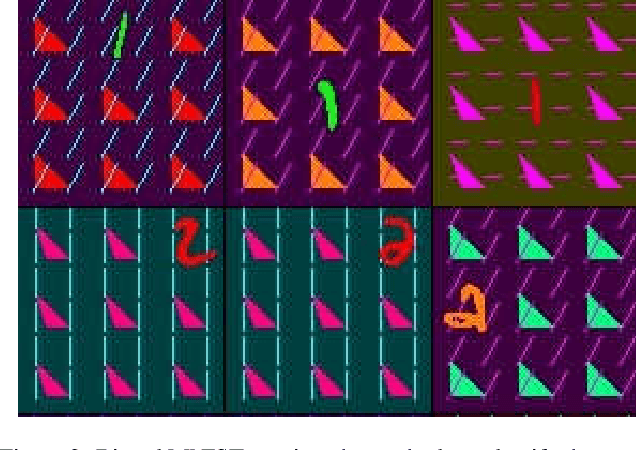
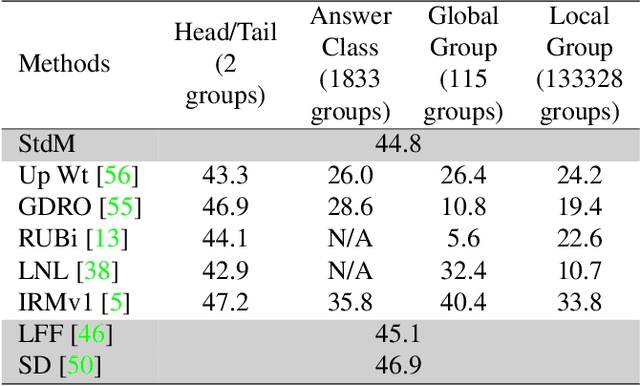
Abstract:A critical problem in deep learning is that systems learn inappropriate biases, resulting in their inability to perform well on minority groups. This has led to the creation of multiple algorithms that endeavor to mitigate bias. However, it is not clear how effective these methods are. This is because study protocols differ among papers, systems are tested on datasets that fail to test many forms of bias, and systems have access to hidden knowledge or are tuned specifically to the test set. To address this, we introduce an improved evaluation protocol, sensible metrics, and a new dataset, which enables us to ask and answer critical questions about bias mitigation algorithms. We evaluate seven state-of-the-art algorithms using the same network architecture and hyperparameter selection policy across three benchmark datasets. We introduce a new dataset called Biased MNIST that enables assessment of robustness to multiple bias sources. We use Biased MNIST and a visual question answering (VQA) benchmark to assess robustness to hidden biases. Rather than only tuning to the test set distribution, we study robustness across different tuning distributions, which is critical because for many applications the test distribution may not be known during development. We find that algorithms exploit hidden biases, are unable to scale to multiple forms of bias, and are highly sensitive to the choice of tuning set. Based on our findings, we implore the community to adopt more rigorous assessment of future bias mitigation methods. All data, code, and results are publicly available at: https://github.com/erobic/bias-mitigators.
Detecting Spurious Correlations with Sanity Tests for Artificial Intelligence Guided Radiology Systems
Mar 04, 2021
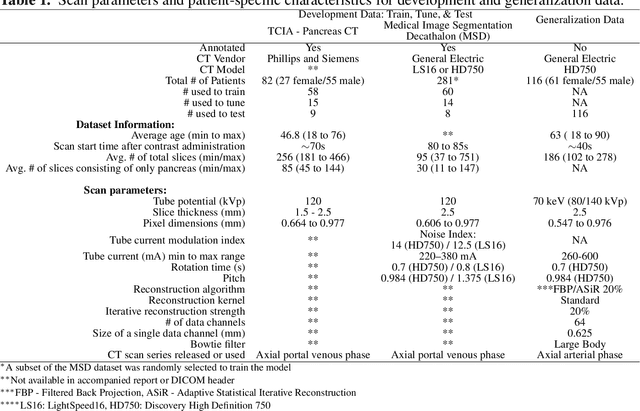
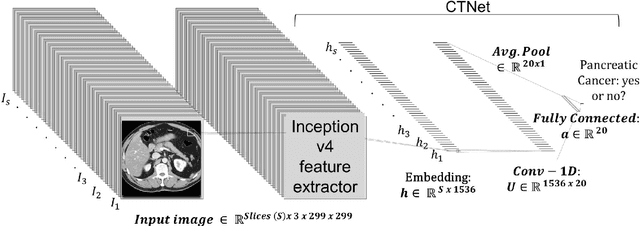
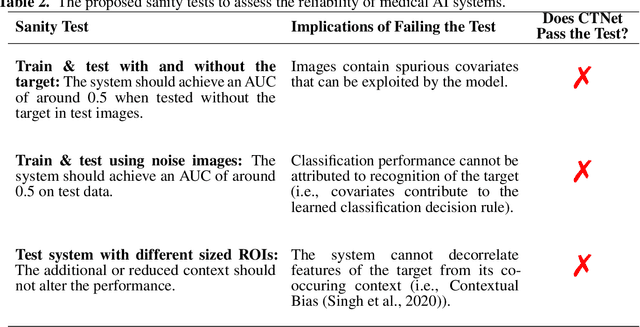
Abstract:Artificial intelligence (AI) has been successful at solving numerous problems in machine perception. In radiology, AI systems are rapidly evolving and show progress in guiding treatment decisions, diagnosing, localizing disease on medical images, and improving radiologists' efficiency. A critical component to deploying AI in radiology is to gain confidence in a developed system's efficacy and safety. The current gold standard approach is to conduct an analytical validation of performance on a generalization dataset from one or more institutions, followed by a clinical validation study of the system's efficacy during deployment. Clinical validation studies are time-consuming, and best practices dictate limited re-use of analytical validation data, so it is ideal to know ahead of time if a system is likely to fail analytical or clinical validation. In this paper, we describe a series of sanity tests to identify when a system performs well on development data for the wrong reasons. We illustrate the sanity tests' value by designing a deep learning system to classify pancreatic cancer seen in computed tomography scans.
On the Value of Out-of-Distribution Testing: An Example of Goodhart's Law
May 19, 2020Abstract:Out-of-distribution (OOD) testing is increasingly popular for evaluating a machine learning system's ability to generalize beyond the biases of a training set. OOD benchmarks are designed to present a different joint distribution of data and labels between training and test time. VQA-CP has become the standard OOD benchmark for visual question answering, but we discovered three troubling practices in its current use. First, most published methods rely on explicit knowledge of the construction of the OOD splits. They often rely on ``inverting'' the distribution of labels, e.g. answering mostly 'yes' when the common training answer is 'no'. Second, the OOD test set is used for model selection. Third, a model's in-domain performance is assessed after retraining it on in-domain splits (VQA v2) that exhibit a more balanced distribution of labels. These three practices defeat the objective of evaluating generalization, and put into question the value of methods specifically designed for this dataset. We show that embarrassingly-simple methods, including one that generates answers at random, surpass the state of the art on some question types. We provide short- and long-term solutions to avoid these pitfalls and realize the benefits of OOD evaluation.
A negative case analysis of visual grounding methods for VQA
Apr 15, 2020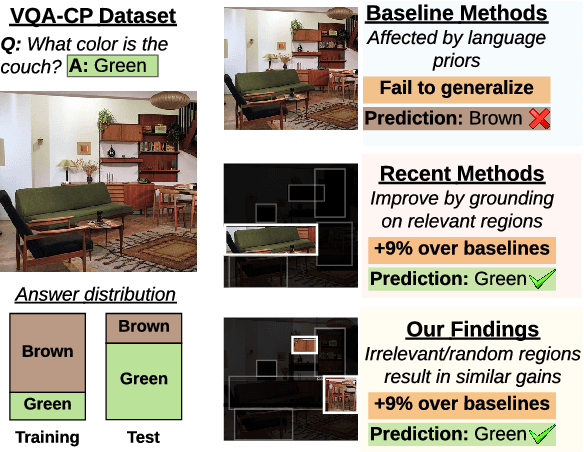
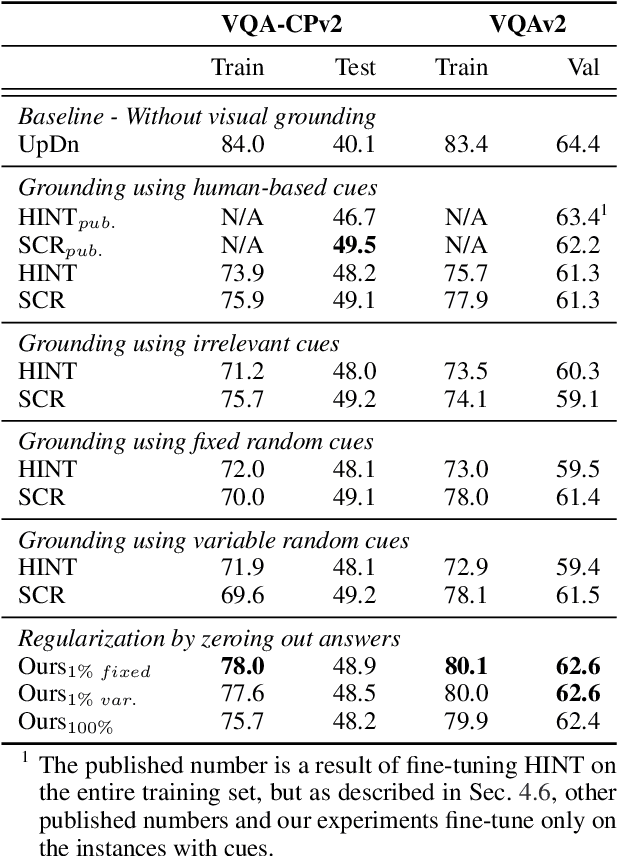
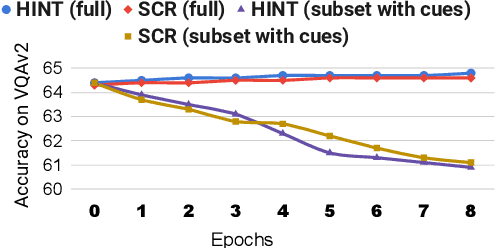
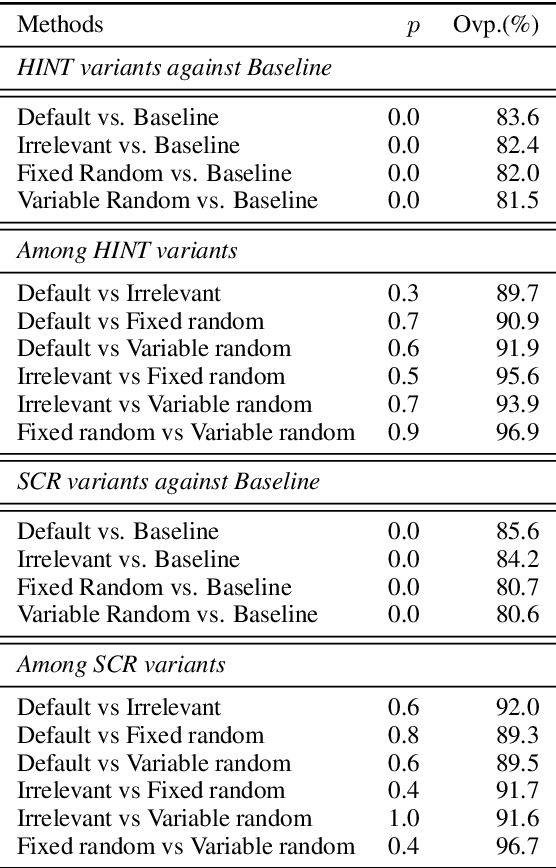
Abstract:Existing Visual Question Answering (VQA) methods tend to exploit dataset biases and spurious statistical correlations, instead of producing right answers for the right reasons. To address this issue, recent bias mitigation methods for VQA propose to incorporate visual cues (e.g., human attention maps) to better ground the VQA models, showcasing impressive gains. However, we show that the performance improvements are not a result of improved visual grounding, but a regularization effect which prevents over-fitting to linguistic priors. For instance, we find that it is not actually necessary to provide proper, human-based cues; random, insensible cues also result in similar improvements. Based on this observation, we propose a simpler regularization scheme that does not require any external annotations and yet achieves near state-of-the-art performance on VQA-CPv2.
REMIND Your Neural Network to Prevent Catastrophic Forgetting
Oct 06, 2019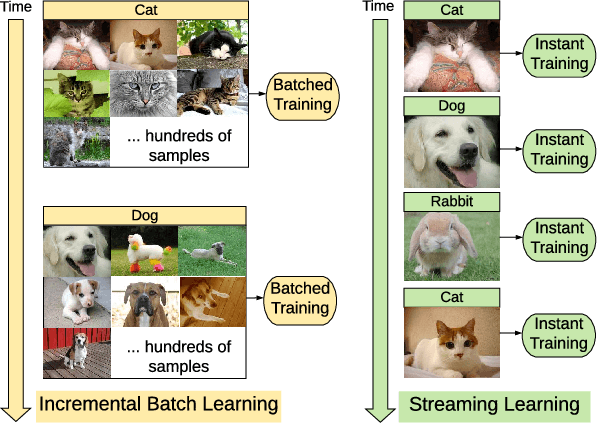
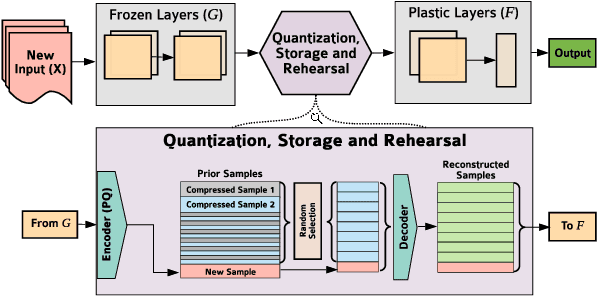
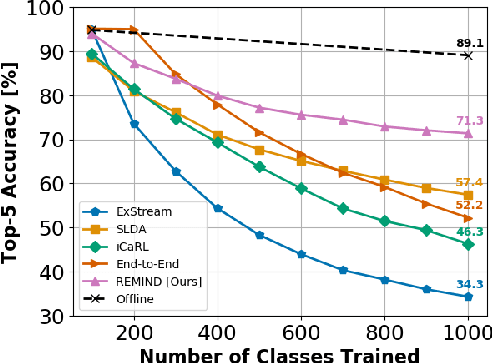
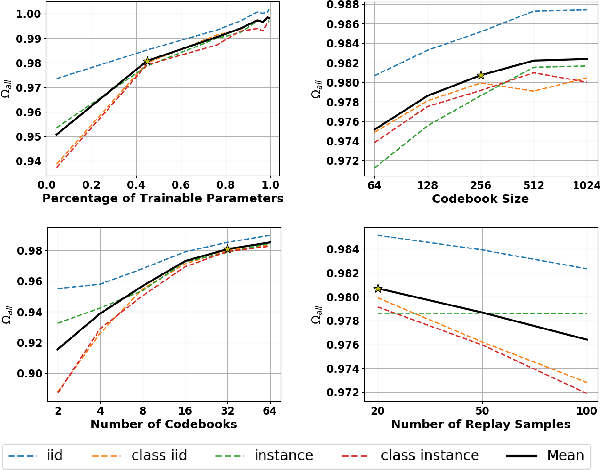
Abstract:In lifelong machine learning, a robotic agent must be incrementally updated with new knowledge, instead of having distinct train and deployment phases. Conventional neural networks are often used for interpreting sensor data, however, if they are updated on non-stationary data streams, they suffer from catastrophic forgetting, with new learning overwriting past knowledge. A common remedy is replay, which involves mixing old examples with new ones. For incrementally training convolutional neural network models, prior work has enabled replay by storing raw images, but this is memory intensive and not ideal for embedded agents. Here, we propose REMIND, a tensor quantization approach that enables efficient replay with tensors. Unlike other methods, REMIND is trained in a streaming manner, meaning it learns one example at a time rather than in large batches containing multiple classes. Our approach achieves state-of-the-art results for incremental class learning on the ImageNet-1K dataset. We also probe REMIND's robustness to different data ordering schemes using the CORe50 streaming dataset. We demonstrate REMIND's generality by pioneering multi-modal incremental learning for visual question answering (VQA), which cannot be readily done with comparison models. We establish strong baselines on the CLEVR and TDIUC datasets for VQA. The generality of REMIND for multi-modal tasks can enable robotic agents to learn about their visual environment using natural language understanding in an interactive way.
 Add to Chrome
Add to Chrome Add to Firefox
Add to Firefox Add to Edge
Add to Edge